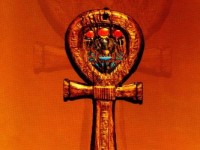12 APRIL, 2019 – 18:45 MARTIN SWEATMAN
https://www.ancient-origins.net/artifacts-other-artifacts/cataclysmic-0011733
Around 13,000 years ago, the Earth burned. A swarm of comet debris from the Taurid meteor stream had blasted the Americas and parts of Europe; the worst day in prehistory since the end of the ice age. Many species of large animal were exterminated by the conflagration and ensuing cataclysms. And those that survived the initial onslaught could do little against the floods, acid rain, and starvation that followed.
People suffered too. Mankind was knocked backwards by this cataclysm into even more primitive stone-age ways of life, leaving sickly, frightened communities battling for survival. Vegetation, and the animals that grazed it, could not live in the weak half-light of day or the starless black of night. And without them, life was bleak and hard.
Many years passed before the dust settled and the stars could be seen again. The sun and moon gradually strengthened and slowly the natural order of things returned. But this devastating cataclysmic event was not forgotten.
The Cataclysmic Birth of Religion
In the Fertile Crescent, modern day southern Turkey, the surviving Natufian tribes memorialized this great catastrophe by erecting Gobekli Tepe, the world’s first temple. The event had changed them – made them more fearful and religious. They prayed at their new stone temple for protection, deliverance, and anything else that might help. And they watched the sky, very carefully.
Their community swelled and their temple grew. Needs were met and they further developed agriculture to support the growing number of sedentary mouths that camped within sight of their monument. Centuries passed and their community developed new skills. Their temple became more complex and ornate, and more famous.
People gathered in their thousands, traveling for hundreds of miles, to witness the greatest accomplishment of their age. They came to read the messages, written with animal symbols and other abstract forms, on Gobekli Tepe’s giant stone pillars, and to take part in its religious ceremonies. Civilization had begun.
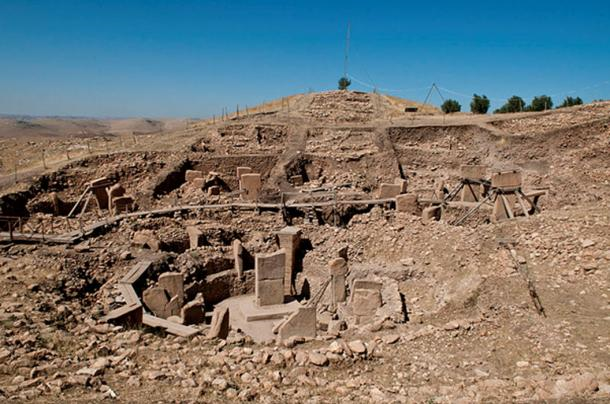
Gobekli Tepe archaeological site, southern Turkey. ( CC BY-SA 3.0 )
It spread like a contagion. The potent mix of religion and agriculture propelled this new lifestyle outwards into the Eurasian and African continents. The greatest revolution in history was underway.
But nothing lasts forever in this world. In time, new cultural centers arose that out-competed Gobekli Tepe. New fashions took hold in each capital, promulgated by those with much to gain, and Gobekli Tepe’s star slowly faded.
Three thousand years after it was founded, Gobekli Tepe was purposefully buried to protect its heritage. The messages written on its walls, effectively witness accounts of the darkest catastrophe in 20,000 years, were hidden from waves of marauding invaders, scheming looters, and many others that walked over it.
Until, that is, they were rediscovered by Klauss Schmidt in 1994. Twenty years after that, Paul Burley and Graham Hancock found the key to unlock these messages and they were read properly again, for the first time in 10,000 years and by me two years ago. Hardly believing what I had stumbled upon, I wrote a peer-reviewed paper, with my colleague Dimitrios Tsikritsis, that hit headlines across the world.
Our ‘Fox’ paper showed the animal symbols at Gobekli Tepe, apart from snakes, represented constellations – the same constellations we know in the West today. The snakes emanating or threatening the animal symbols therefore represented meteors from the Taurid meteor stream. One pillar in particular, Pillar 43, is especially important as it allows their writing to be decoded using statistical methods. It is our Rosetta Stone. And the message written on this pillar is profound – as it very likely encodes the date of the Younger Dryas event itself, written in terms of precession of the equinoxes.
This pillar reveals many new insights that overthrow commonly accepted norms of scholarship. It is revolutionary. Most importantly, it tells us that ancient people were far more sophisticated astronomers than previously thought. And it also confirms that Clube and Napier’s coherent catastrophism, a theory that proposes multiple devastating comet impacts on Earth over the last 20,000 years or so, with perhaps more to come, is correct. Essentially, it tells us to ‘beware’, for the cosmos is not as safe as once thought.
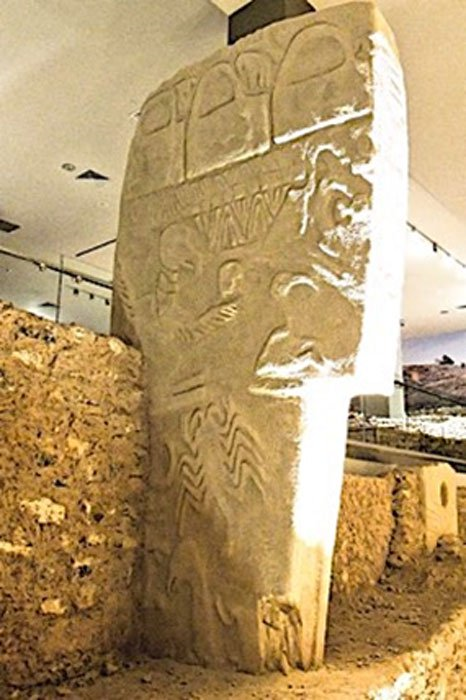
Copy of Pillar 43 in Sanliurfa museum. ( Image courtesy of Alistair Coombs, author supplied)
Clearly, this is not the story we tell our children, or we were told as children. Most academics across the Earth Sciences still hold to the ‘uniformitarian’ paradigm developed over 200 years ago by James Hutton, which reassures us that Earth is safe from these kinds of devastating impact. While the dinosaur-killing asteroid story has been bought by most, uniformitarianism maintains that such events could not have happened over the timespan of human development. These events are, supposedly, about as rare as fairies.
Staying Safe from Cataclysmic Events
But we now know this view is wrong. It is a delusion. Uniformitarianism is dead and should be buried. In any case, every scientist should automatically be suspicious of it. In technical terms, uniformitarianism is an extreme form of ‘extrapolation’. It proposes that only the geological process we have witnessed over the last few hundred years (corresponding to the scientific revolution) can have ever happened on Earth, or at least within the last few million years. It effectively ignores rare events, in particular those originating from space. But as any decent scientist knows, rare events often dominate complex systems, like Earth’s environment. And, in general, extrapolations are normally avoided altogether in science, or used only with great caution. So why has uniformitarianism been so popular?
I’m not sure of the answer to this. Possibly there is a psychological dimension to it. Perhaps, speaking generally, we would rather not confront the dangers that face us, especially if there is little we can do about them. Nevertheless, from a scientific perspective, uniformitarianism is wholly unsatisfactory and needs to be binned.
How can I be so confident of this? How can I state with such assurance that most of academia has got it wrong, while I and at least 70 other scientists (including the Comet Research Group) are right? Well, apart from the lunacy of uniformitarianism, there are three major lines of physical evidence the cataclysm to draw on, each of which is iron-clad and revolutionary in its own right.
Combined, they all point in the same direction to provide an unassailable paradigm changing case. Briefly, there is the geochemical, astronomical, and archaeological evidence.
Beginning with geochemistry, it is now known that a disaster of cosmic dimensions struck earth nearly 13,000 years ago. Nanodiamonds, microscopic iridium-enriched magnetic grains and elevated levels of platinum, all of which are strong indicators of a comet impact, have been found at the base of the Younger Dryas Boundary (or Black Mat) – a ubiquitous layer of discolored sediment dating to the onset of the Younger Dryas mini ice-age. Their presence, spanning at least three continents, has been confirmed by multiple independent research groups within the last 10 years. Moreover, a frozen layer of platinum dust occurs in the Greenland ice sheet at precisely the same time ‘horizon’. Attempts to refute this evidence are badly flawed in a fundamental and surprisingly basic way.
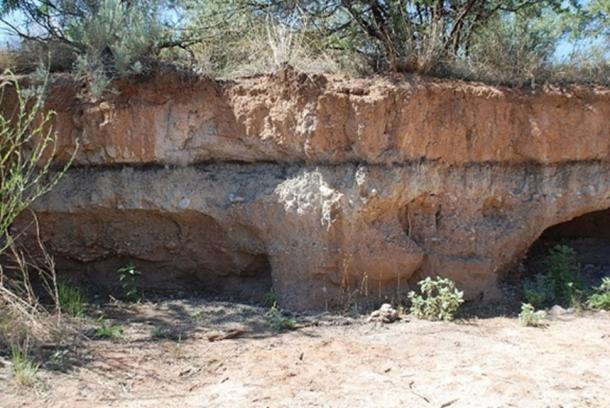
The Younger Dryas ‘black mat’. (I mage courtesy of the Comet Research Group, a uthor supplied)
o The Ancestral Myth of the Hollow Earth and Underground Civilizations
o Myths and Meteors: How Ancient Cultures Explained Comets and Other Chunks of Rock Falling From the Sky
o New Telescope Observes Otherwise Invisible Terrestrial Entities with Intelligent Movement
Next, there is the astronomical evidence. Observations of comets beyond Jupiter, the frequency with which they enter the inner solar system, and their fragmentation within the inner solar system , all suggest that intense comet impacts on Earth with global consequences are expected on the timescale of human development.

Distribution of the Younger Dryas Boundary. ( Image courtesy of the Comet Research Group author supplied)
Moreover, observations of comet fragments accompanying Encke in the Taurid meteor stream, along with the massive zodiacal dust cloud, strongly suggest they should also have occurred on the even shorter timescale of human civilization. Indeed, it would be a major surprise if none were found. Therefore, an event on the scale of the Younger Dryas impact nearly 13,000 years ago is entirely expected.
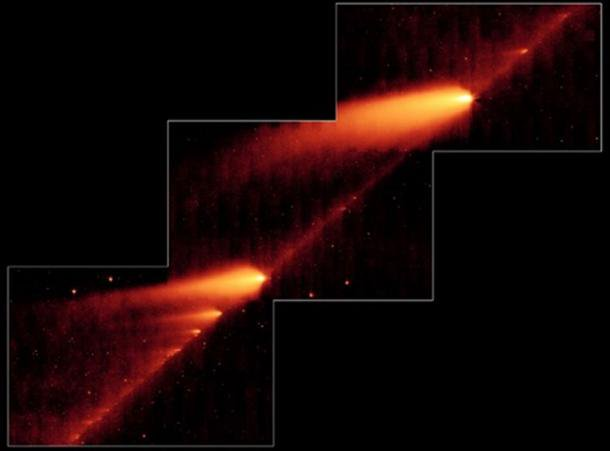
Break-up of comet 73P, Schwassmann-Wachmann, observed with the Spitzer Space Telescope. ( Image courtesy of NASA/JPL-Caltech/W. Reach, a uthor supplied)
Ancient Astronomers
Finally, we have the animal symbols at Gobekli Tepe and in cave art. The general view is that these are examples of ‘animism’, a kind of shamanism. However, we now know, without a shadow of doubt, that these animal symbols are symbolic, and actually represent the same star constellations we know today on the various equinoxes and solstices. They demonstrate that precession of the equinoxes was known many tens of thousands of years ago, and therefore that Hipparchus of the Ancient Greeks were not the first to discover this effect in the 2 nd century BC, as commonly believed.
Gobekli Tepe and Pillar 43 provided the key to understanding this, but our Fox paper left some room for doubt. This doubt has been effectively eliminated by my more recent peer-reviewed paper, this time with Alistair Coombs, that demonstrates that the same zodiacal system can be used to ‘read’ west European cave art, such as at Lascaux, Chauvet and Altamira. Indeed, the Lascaux Shaft Scene can be interpreted as a memorial to another devastating comet impact, this time in 15,150 BC. This is no mere speculation – our zodiacal theory has been proven in a scientific sense.
The Lascaux Shaft Scene. (Image courtesy of Alistair Coombs, author supplied)
Indeed, even the earliest accepted example of figurative art, the 40,000 year old Lion-man of Hohlenstadel cave, obeys this zodiacal system – in this case this sculpture likely represents the constellation Cancer on the winter solstice at that time.
All this evidence, and more, is summarized in my recent book Prehistory Decoded . As well as piecing this evidence together to create a coherent picture of the last 40,000 years, I also show how it relates to the origin of civilization, the origin of religion, and the true age of the Great Sphinx .
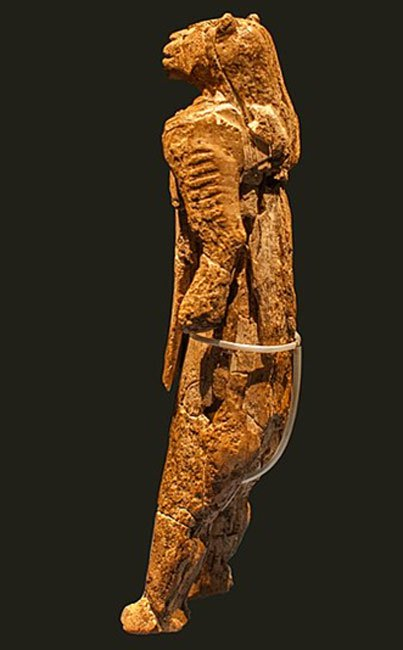
The Lion-man of Hohlenstadel cave. (Thilo Parg / CC BY-SA 3.0 )
What do you think about this piece? Share your comment in the comment thread and share the story using the social media buttons above. You may reach the editor on 0249579664. Thank you.


